Singapore's MICE Industry: Development, Impacts and Recommendations
VerifiedAdded on 2020/03/01
|9
|2277
|39
Report
AI Summary
This report provides a comprehensive analysis of the MICE (Meetings, Incentives, Conferences, and Exhibitions) industry in Singapore. It begins with an introduction highlighting the industry's significance in the global tourism landscape and its contribution to economic development. The main body delves into the development of the MICE sector in Singapore, emphasizing its appeal as a premier destination due to factors like excellent connectivity, a vibrant business ecosystem, and efficient infrastructure. The report explores the impacts of the MICE industry on Singapore, referencing the Butler tourism model to illustrate the stages of destination development and the crucial role of stakeholders in the success of mega-events. It also examines the economic contributions of MICE events, such as the Singapore Airshow, and their positive effects on employment and community development. Furthermore, the report offers recommendations to enhance Singapore's appeal to the MICE market, including becoming a more connected city, focusing on experiential events, and improving the efficiency of MICE companies. The conclusion summarizes the key findings, emphasizing the strong correlation between tourism suppliers, promoters, and the overall success of MICE events in driving growth within the tourism sector.
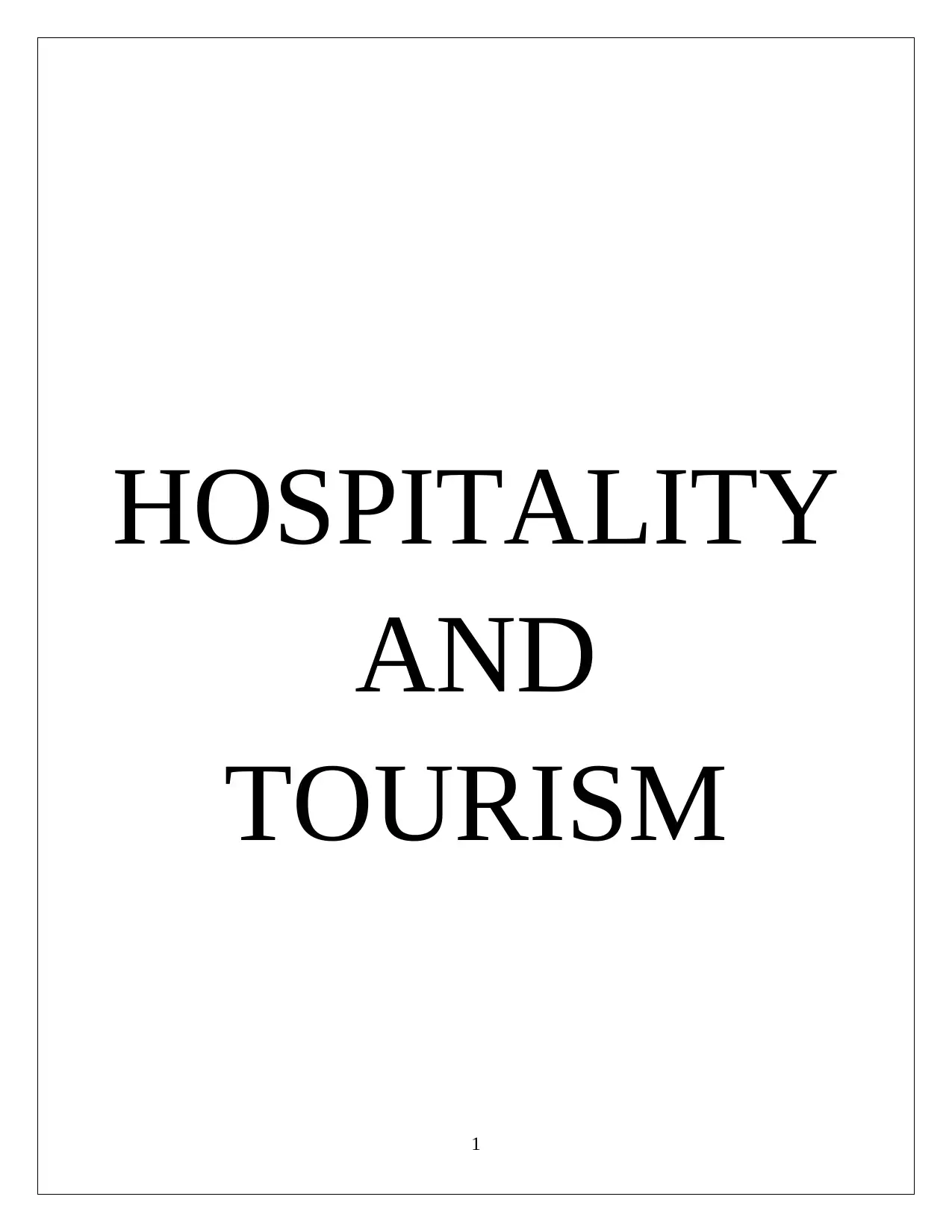
HOSPITALITY
AND
TOURISM
1
AND
TOURISM
1
Paraphrase This Document
Need a fresh take? Get an instant paraphrase of this document with our AI Paraphraser
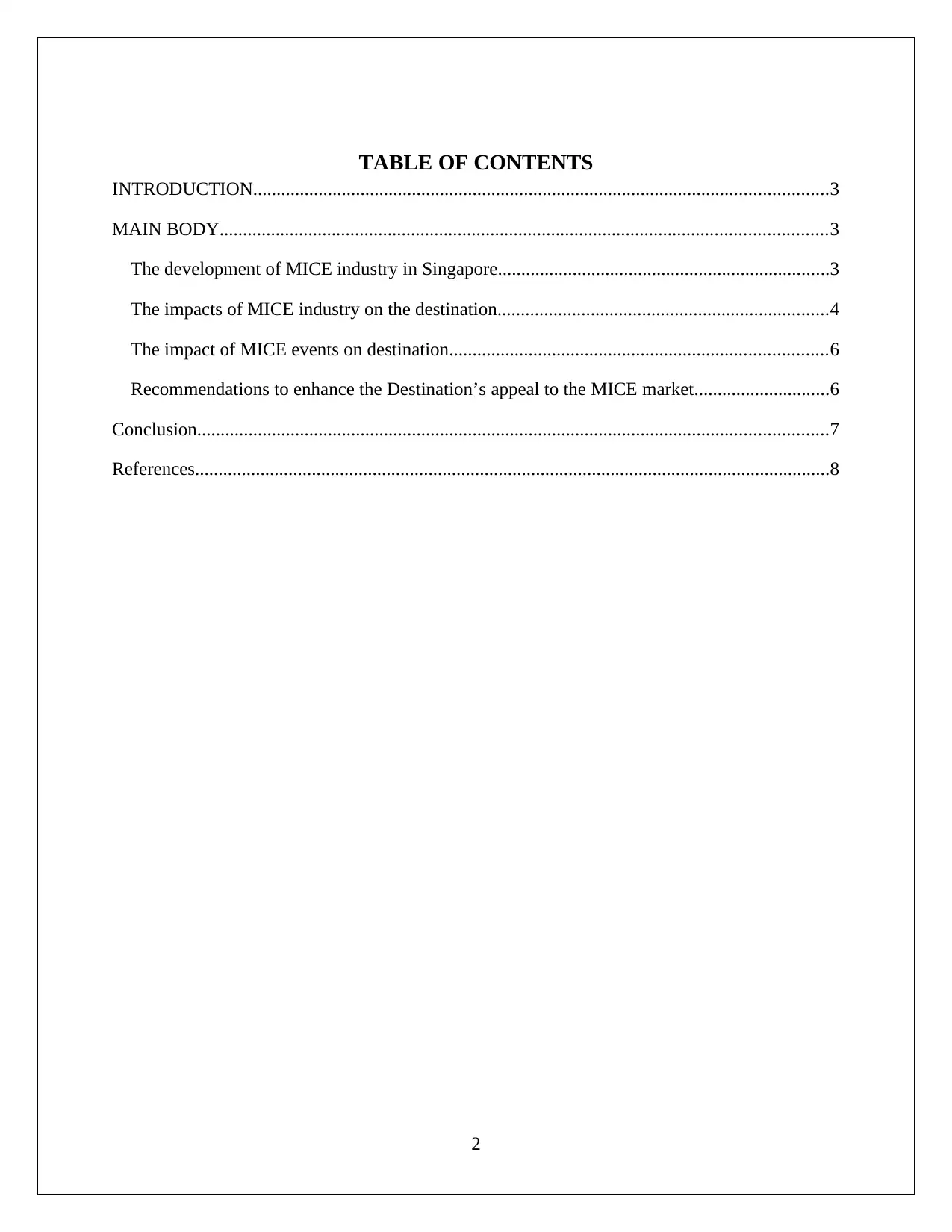
TABLE OF CONTENTS
INTRODUCTION...........................................................................................................................3
MAIN BODY..................................................................................................................................3
The development of MICE industry in Singapore.......................................................................3
The impacts of MICE industry on the destination.......................................................................4
The impact of MICE events on destination.................................................................................6
Recommendations to enhance the Destination’s appeal to the MICE market.............................6
Conclusion.......................................................................................................................................7
References........................................................................................................................................8
2
INTRODUCTION...........................................................................................................................3
MAIN BODY..................................................................................................................................3
The development of MICE industry in Singapore.......................................................................3
The impacts of MICE industry on the destination.......................................................................4
The impact of MICE events on destination.................................................................................6
Recommendations to enhance the Destination’s appeal to the MICE market.............................6
Conclusion.......................................................................................................................................7
References........................................................................................................................................8
2
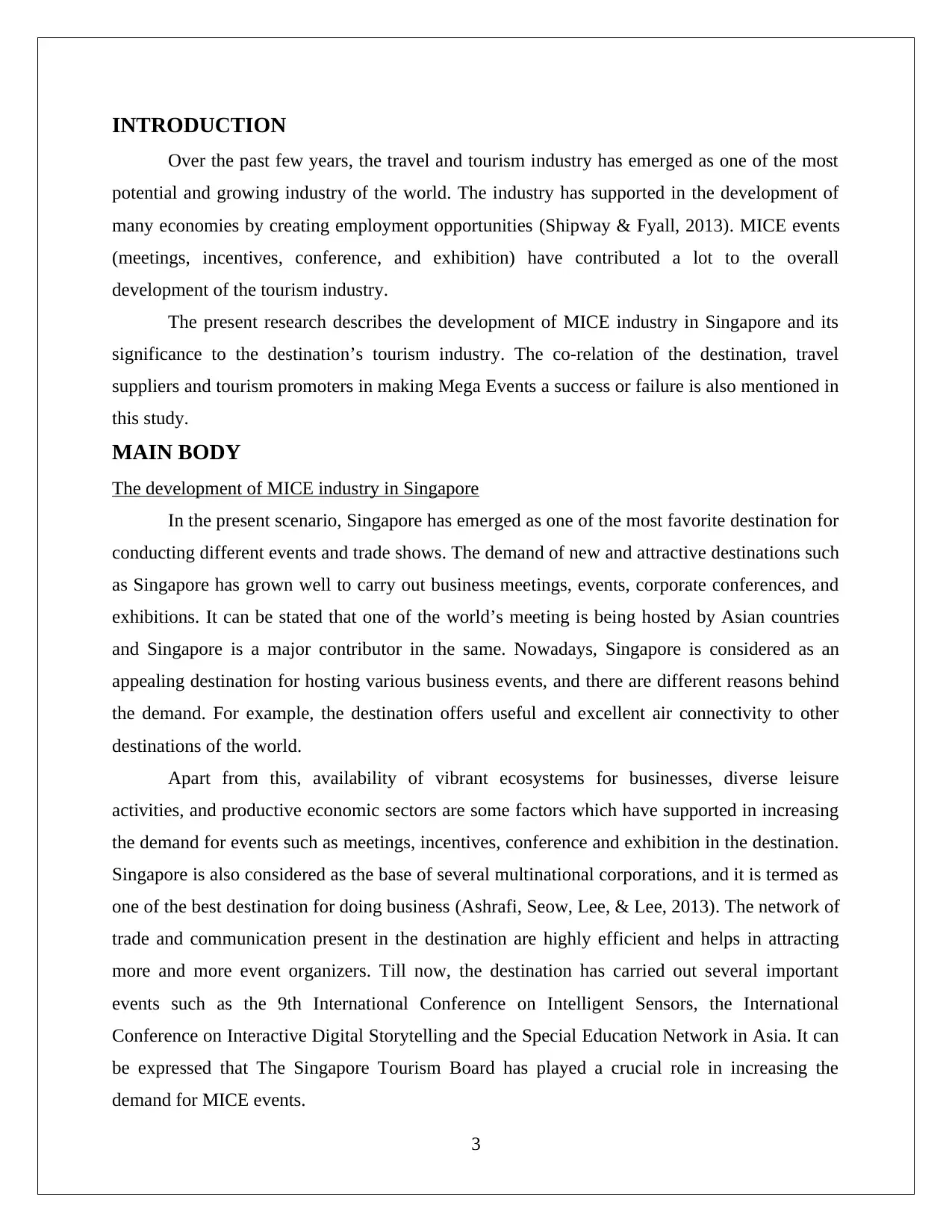
INTRODUCTION
Over the past few years, the travel and tourism industry has emerged as one of the most
potential and growing industry of the world. The industry has supported in the development of
many economies by creating employment opportunities (Shipway & Fyall, 2013). MICE events
(meetings, incentives, conference, and exhibition) have contributed a lot to the overall
development of the tourism industry.
The present research describes the development of MICE industry in Singapore and its
significance to the destination’s tourism industry. The co-relation of the destination, travel
suppliers and tourism promoters in making Mega Events a success or failure is also mentioned in
this study.
MAIN BODY
The development of MICE industry in Singapore
In the present scenario, Singapore has emerged as one of the most favorite destination for
conducting different events and trade shows. The demand of new and attractive destinations such
as Singapore has grown well to carry out business meetings, events, corporate conferences, and
exhibitions. It can be stated that one of the world’s meeting is being hosted by Asian countries
and Singapore is a major contributor in the same. Nowadays, Singapore is considered as an
appealing destination for hosting various business events, and there are different reasons behind
the demand. For example, the destination offers useful and excellent air connectivity to other
destinations of the world.
Apart from this, availability of vibrant ecosystems for businesses, diverse leisure
activities, and productive economic sectors are some factors which have supported in increasing
the demand for events such as meetings, incentives, conference and exhibition in the destination.
Singapore is also considered as the base of several multinational corporations, and it is termed as
one of the best destination for doing business (Ashrafi, Seow, Lee, & Lee, 2013). The network of
trade and communication present in the destination are highly efficient and helps in attracting
more and more event organizers. Till now, the destination has carried out several important
events such as the 9th International Conference on Intelligent Sensors, the International
Conference on Interactive Digital Storytelling and the Special Education Network in Asia. It can
be expressed that The Singapore Tourism Board has played a crucial role in increasing the
demand for MICE events.
3
Over the past few years, the travel and tourism industry has emerged as one of the most
potential and growing industry of the world. The industry has supported in the development of
many economies by creating employment opportunities (Shipway & Fyall, 2013). MICE events
(meetings, incentives, conference, and exhibition) have contributed a lot to the overall
development of the tourism industry.
The present research describes the development of MICE industry in Singapore and its
significance to the destination’s tourism industry. The co-relation of the destination, travel
suppliers and tourism promoters in making Mega Events a success or failure is also mentioned in
this study.
MAIN BODY
The development of MICE industry in Singapore
In the present scenario, Singapore has emerged as one of the most favorite destination for
conducting different events and trade shows. The demand of new and attractive destinations such
as Singapore has grown well to carry out business meetings, events, corporate conferences, and
exhibitions. It can be stated that one of the world’s meeting is being hosted by Asian countries
and Singapore is a major contributor in the same. Nowadays, Singapore is considered as an
appealing destination for hosting various business events, and there are different reasons behind
the demand. For example, the destination offers useful and excellent air connectivity to other
destinations of the world.
Apart from this, availability of vibrant ecosystems for businesses, diverse leisure
activities, and productive economic sectors are some factors which have supported in increasing
the demand for events such as meetings, incentives, conference and exhibition in the destination.
Singapore is also considered as the base of several multinational corporations, and it is termed as
one of the best destination for doing business (Ashrafi, Seow, Lee, & Lee, 2013). The network of
trade and communication present in the destination are highly efficient and helps in attracting
more and more event organizers. Till now, the destination has carried out several important
events such as the 9th International Conference on Intelligent Sensors, the International
Conference on Interactive Digital Storytelling and the Special Education Network in Asia. It can
be expressed that The Singapore Tourism Board has played a crucial role in increasing the
demand for MICE events.
3
⊘ This is a preview!⊘
Do you want full access?
Subscribe today to unlock all pages.

Trusted by 1+ million students worldwide
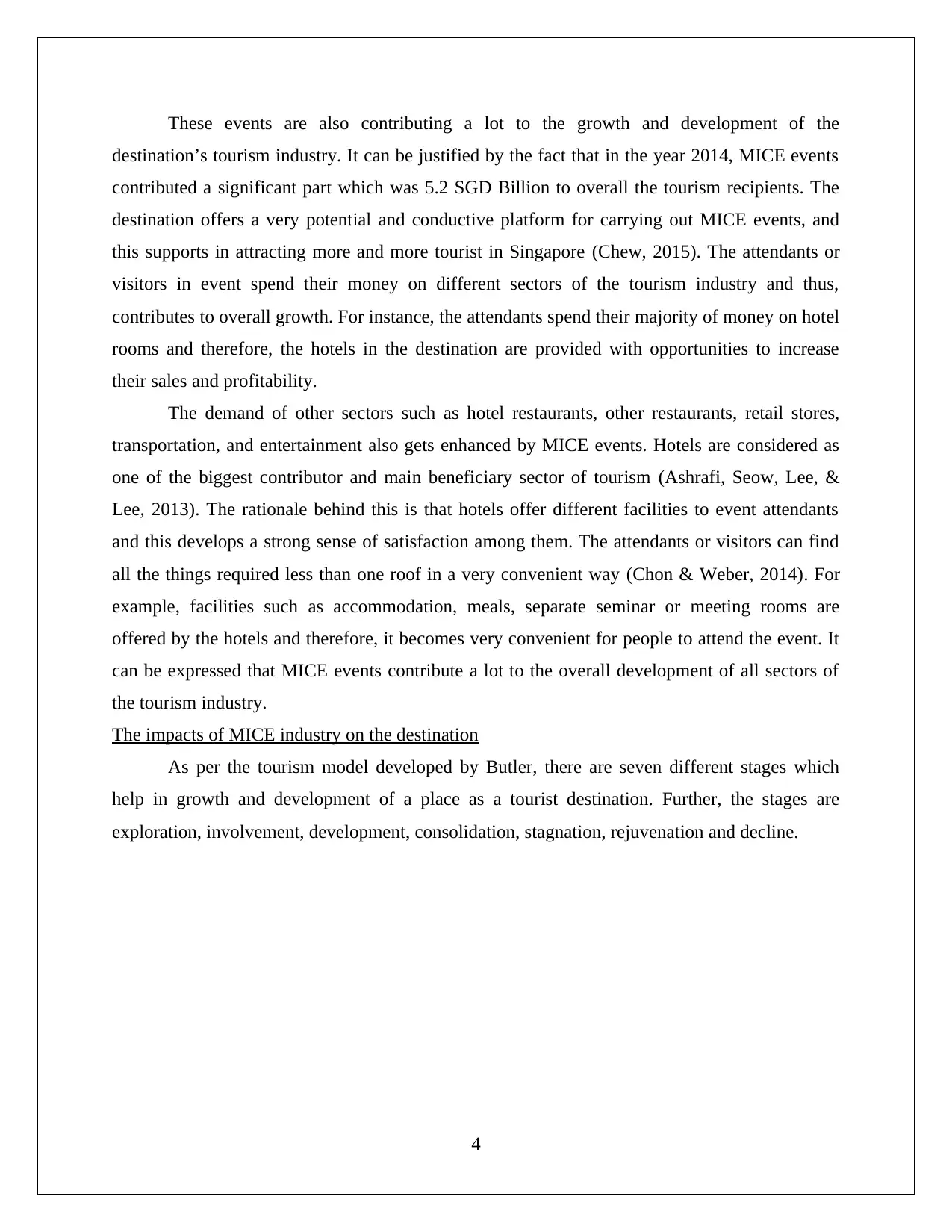
These events are also contributing a lot to the growth and development of the
destination’s tourism industry. It can be justified by the fact that in the year 2014, MICE events
contributed a significant part which was 5.2 SGD Billion to overall the tourism recipients. The
destination offers a very potential and conductive platform for carrying out MICE events, and
this supports in attracting more and more tourist in Singapore (Chew, 2015). The attendants or
visitors in event spend their money on different sectors of the tourism industry and thus,
contributes to overall growth. For instance, the attendants spend their majority of money on hotel
rooms and therefore, the hotels in the destination are provided with opportunities to increase
their sales and profitability.
The demand of other sectors such as hotel restaurants, other restaurants, retail stores,
transportation, and entertainment also gets enhanced by MICE events. Hotels are considered as
one of the biggest contributor and main beneficiary sector of tourism (Ashrafi, Seow, Lee, &
Lee, 2013). The rationale behind this is that hotels offer different facilities to event attendants
and this develops a strong sense of satisfaction among them. The attendants or visitors can find
all the things required less than one roof in a very convenient way (Chon & Weber, 2014). For
example, facilities such as accommodation, meals, separate seminar or meeting rooms are
offered by the hotels and therefore, it becomes very convenient for people to attend the event. It
can be expressed that MICE events contribute a lot to the overall development of all sectors of
the tourism industry.
The impacts of MICE industry on the destination
As per the tourism model developed by Butler, there are seven different stages which
help in growth and development of a place as a tourist destination. Further, the stages are
exploration, involvement, development, consolidation, stagnation, rejuvenation and decline.
4
destination’s tourism industry. It can be justified by the fact that in the year 2014, MICE events
contributed a significant part which was 5.2 SGD Billion to overall the tourism recipients. The
destination offers a very potential and conductive platform for carrying out MICE events, and
this supports in attracting more and more tourist in Singapore (Chew, 2015). The attendants or
visitors in event spend their money on different sectors of the tourism industry and thus,
contributes to overall growth. For instance, the attendants spend their majority of money on hotel
rooms and therefore, the hotels in the destination are provided with opportunities to increase
their sales and profitability.
The demand of other sectors such as hotel restaurants, other restaurants, retail stores,
transportation, and entertainment also gets enhanced by MICE events. Hotels are considered as
one of the biggest contributor and main beneficiary sector of tourism (Ashrafi, Seow, Lee, &
Lee, 2013). The rationale behind this is that hotels offer different facilities to event attendants
and this develops a strong sense of satisfaction among them. The attendants or visitors can find
all the things required less than one roof in a very convenient way (Chon & Weber, 2014). For
example, facilities such as accommodation, meals, separate seminar or meeting rooms are
offered by the hotels and therefore, it becomes very convenient for people to attend the event. It
can be expressed that MICE events contribute a lot to the overall development of all sectors of
the tourism industry.
The impacts of MICE industry on the destination
As per the tourism model developed by Butler, there are seven different stages which
help in growth and development of a place as a tourist destination. Further, the stages are
exploration, involvement, development, consolidation, stagnation, rejuvenation and decline.
4
Paraphrase This Document
Need a fresh take? Get an instant paraphrase of this document with our AI Paraphraser
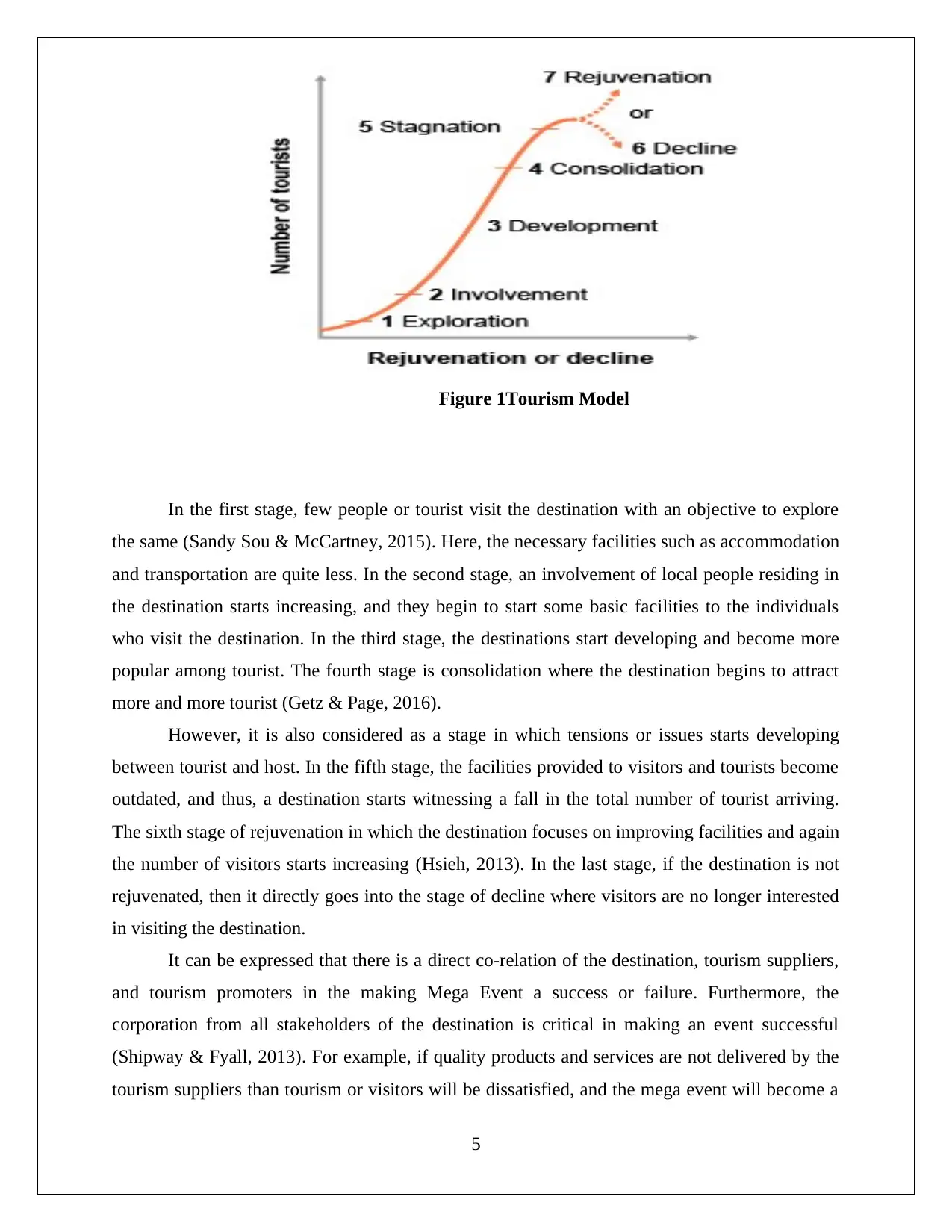
In the first stage, few people or tourist visit the destination with an objective to explore
the same (Sandy Sou & McCartney, 2015). Here, the necessary facilities such as accommodation
and transportation are quite less. In the second stage, an involvement of local people residing in
the destination starts increasing, and they begin to start some basic facilities to the individuals
who visit the destination. In the third stage, the destinations start developing and become more
popular among tourist. The fourth stage is consolidation where the destination begins to attract
more and more tourist (Getz & Page, 2016).
However, it is also considered as a stage in which tensions or issues starts developing
between tourist and host. In the fifth stage, the facilities provided to visitors and tourists become
outdated, and thus, a destination starts witnessing a fall in the total number of tourist arriving.
The sixth stage of rejuvenation in which the destination focuses on improving facilities and again
the number of visitors starts increasing (Hsieh, 2013). In the last stage, if the destination is not
rejuvenated, then it directly goes into the stage of decline where visitors are no longer interested
in visiting the destination.
It can be expressed that there is a direct co-relation of the destination, tourism suppliers,
and tourism promoters in the making Mega Event a success or failure. Furthermore, the
corporation from all stakeholders of the destination is critical in making an event successful
(Shipway & Fyall, 2013). For example, if quality products and services are not delivered by the
tourism suppliers than tourism or visitors will be dissatisfied, and the mega event will become a
5
Figure 1Tourism Model
the same (Sandy Sou & McCartney, 2015). Here, the necessary facilities such as accommodation
and transportation are quite less. In the second stage, an involvement of local people residing in
the destination starts increasing, and they begin to start some basic facilities to the individuals
who visit the destination. In the third stage, the destinations start developing and become more
popular among tourist. The fourth stage is consolidation where the destination begins to attract
more and more tourist (Getz & Page, 2016).
However, it is also considered as a stage in which tensions or issues starts developing
between tourist and host. In the fifth stage, the facilities provided to visitors and tourists become
outdated, and thus, a destination starts witnessing a fall in the total number of tourist arriving.
The sixth stage of rejuvenation in which the destination focuses on improving facilities and again
the number of visitors starts increasing (Hsieh, 2013). In the last stage, if the destination is not
rejuvenated, then it directly goes into the stage of decline where visitors are no longer interested
in visiting the destination.
It can be expressed that there is a direct co-relation of the destination, tourism suppliers,
and tourism promoters in the making Mega Event a success or failure. Furthermore, the
corporation from all stakeholders of the destination is critical in making an event successful
(Shipway & Fyall, 2013). For example, if quality products and services are not delivered by the
tourism suppliers than tourism or visitors will be dissatisfied, and the mega event will become a
5
Figure 1Tourism Model
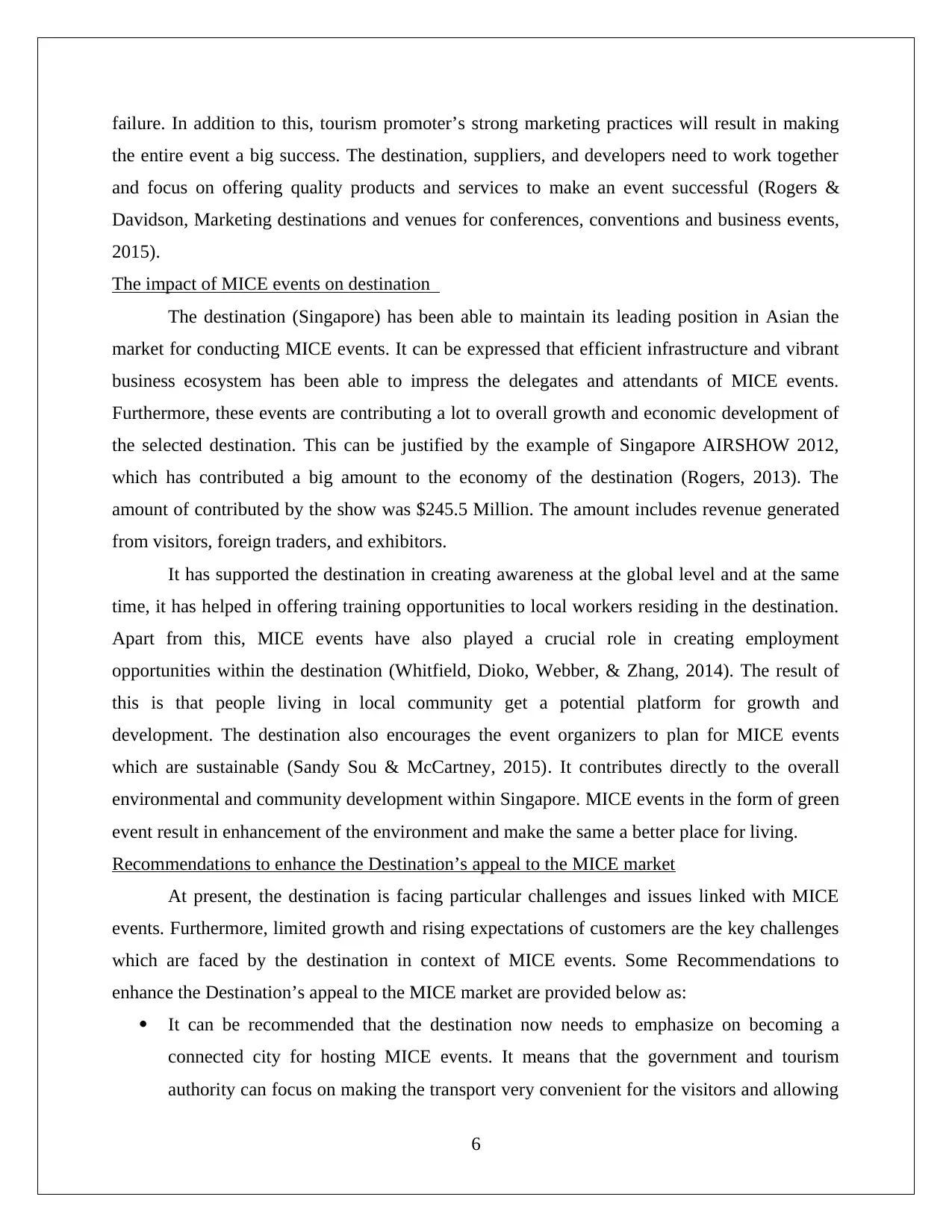
failure. In addition to this, tourism promoter’s strong marketing practices will result in making
the entire event a big success. The destination, suppliers, and developers need to work together
and focus on offering quality products and services to make an event successful (Rogers &
Davidson, Marketing destinations and venues for conferences, conventions and business events,
2015).
The impact of MICE events on destination
The destination (Singapore) has been able to maintain its leading position in Asian the
market for conducting MICE events. It can be expressed that efficient infrastructure and vibrant
business ecosystem has been able to impress the delegates and attendants of MICE events.
Furthermore, these events are contributing a lot to overall growth and economic development of
the selected destination. This can be justified by the example of Singapore AIRSHOW 2012,
which has contributed a big amount to the economy of the destination (Rogers, 2013). The
amount of contributed by the show was $245.5 Million. The amount includes revenue generated
from visitors, foreign traders, and exhibitors.
It has supported the destination in creating awareness at the global level and at the same
time, it has helped in offering training opportunities to local workers residing in the destination.
Apart from this, MICE events have also played a crucial role in creating employment
opportunities within the destination (Whitfield, Dioko, Webber, & Zhang, 2014). The result of
this is that people living in local community get a potential platform for growth and
development. The destination also encourages the event organizers to plan for MICE events
which are sustainable (Sandy Sou & McCartney, 2015). It contributes directly to the overall
environmental and community development within Singapore. MICE events in the form of green
event result in enhancement of the environment and make the same a better place for living.
Recommendations to enhance the Destination’s appeal to the MICE market
At present, the destination is facing particular challenges and issues linked with MICE
events. Furthermore, limited growth and rising expectations of customers are the key challenges
which are faced by the destination in context of MICE events. Some Recommendations to
enhance the Destination’s appeal to the MICE market are provided below as:
It can be recommended that the destination now needs to emphasize on becoming a
connected city for hosting MICE events. It means that the government and tourism
authority can focus on making the transport very convenient for the visitors and allowing
6
the entire event a big success. The destination, suppliers, and developers need to work together
and focus on offering quality products and services to make an event successful (Rogers &
Davidson, Marketing destinations and venues for conferences, conventions and business events,
2015).
The impact of MICE events on destination
The destination (Singapore) has been able to maintain its leading position in Asian the
market for conducting MICE events. It can be expressed that efficient infrastructure and vibrant
business ecosystem has been able to impress the delegates and attendants of MICE events.
Furthermore, these events are contributing a lot to overall growth and economic development of
the selected destination. This can be justified by the example of Singapore AIRSHOW 2012,
which has contributed a big amount to the economy of the destination (Rogers, 2013). The
amount of contributed by the show was $245.5 Million. The amount includes revenue generated
from visitors, foreign traders, and exhibitors.
It has supported the destination in creating awareness at the global level and at the same
time, it has helped in offering training opportunities to local workers residing in the destination.
Apart from this, MICE events have also played a crucial role in creating employment
opportunities within the destination (Whitfield, Dioko, Webber, & Zhang, 2014). The result of
this is that people living in local community get a potential platform for growth and
development. The destination also encourages the event organizers to plan for MICE events
which are sustainable (Sandy Sou & McCartney, 2015). It contributes directly to the overall
environmental and community development within Singapore. MICE events in the form of green
event result in enhancement of the environment and make the same a better place for living.
Recommendations to enhance the Destination’s appeal to the MICE market
At present, the destination is facing particular challenges and issues linked with MICE
events. Furthermore, limited growth and rising expectations of customers are the key challenges
which are faced by the destination in context of MICE events. Some Recommendations to
enhance the Destination’s appeal to the MICE market are provided below as:
It can be recommended that the destination now needs to emphasize on becoming a
connected city for hosting MICE events. It means that the government and tourism
authority can focus on making the transport very convenient for the visitors and allowing
6
⊘ This is a preview!⊘
Do you want full access?
Subscribe today to unlock all pages.

Trusted by 1+ million students worldwide
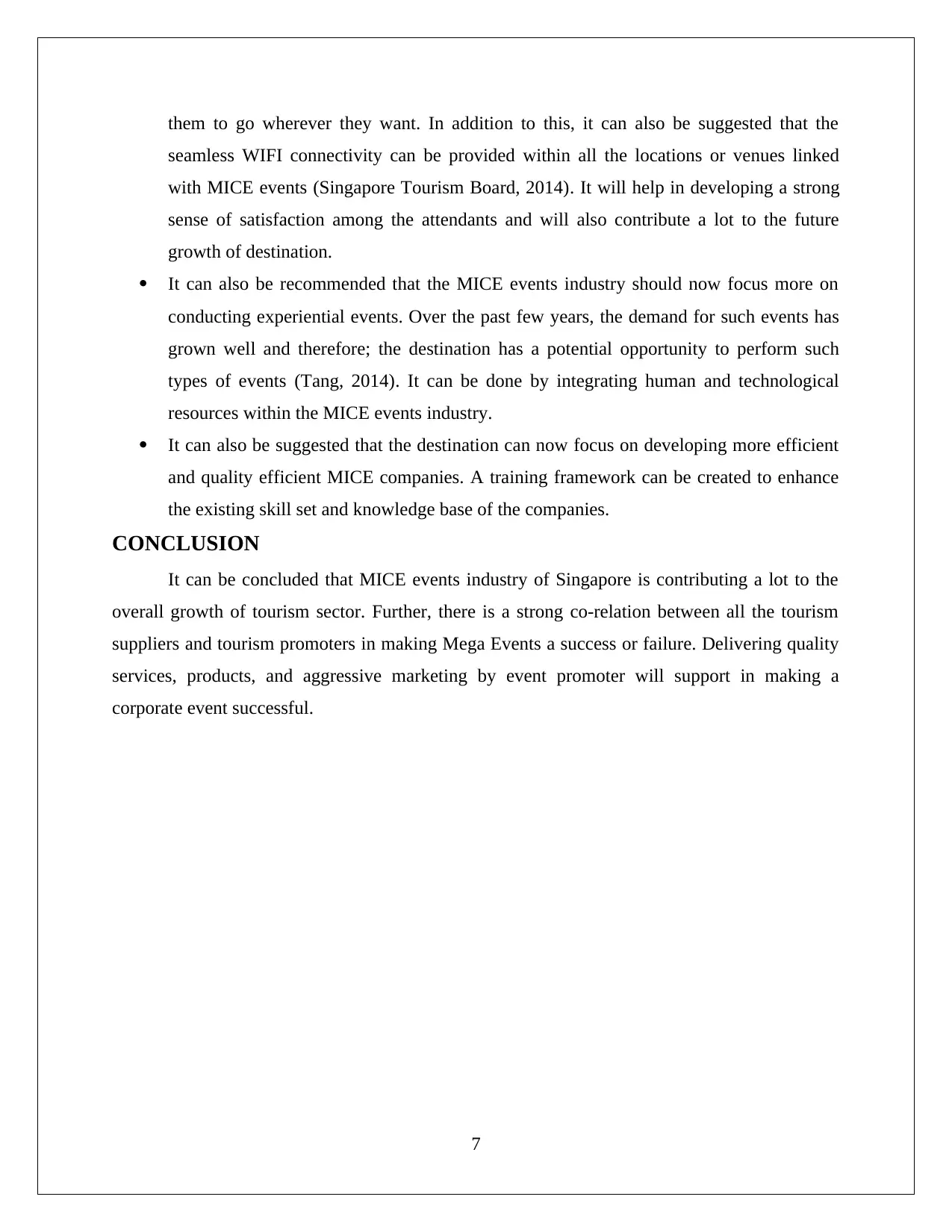
them to go wherever they want. In addition to this, it can also be suggested that the
seamless WIFI connectivity can be provided within all the locations or venues linked
with MICE events (Singapore Tourism Board, 2014). It will help in developing a strong
sense of satisfaction among the attendants and will also contribute a lot to the future
growth of destination.
It can also be recommended that the MICE events industry should now focus more on
conducting experiential events. Over the past few years, the demand for such events has
grown well and therefore; the destination has a potential opportunity to perform such
types of events (Tang, 2014). It can be done by integrating human and technological
resources within the MICE events industry.
It can also be suggested that the destination can now focus on developing more efficient
and quality efficient MICE companies. A training framework can be created to enhance
the existing skill set and knowledge base of the companies.
CONCLUSION
It can be concluded that MICE events industry of Singapore is contributing a lot to the
overall growth of tourism sector. Further, there is a strong co-relation between all the tourism
suppliers and tourism promoters in making Mega Events a success or failure. Delivering quality
services, products, and aggressive marketing by event promoter will support in making a
corporate event successful.
7
seamless WIFI connectivity can be provided within all the locations or venues linked
with MICE events (Singapore Tourism Board, 2014). It will help in developing a strong
sense of satisfaction among the attendants and will also contribute a lot to the future
growth of destination.
It can also be recommended that the MICE events industry should now focus more on
conducting experiential events. Over the past few years, the demand for such events has
grown well and therefore; the destination has a potential opportunity to perform such
types of events (Tang, 2014). It can be done by integrating human and technological
resources within the MICE events industry.
It can also be suggested that the destination can now focus on developing more efficient
and quality efficient MICE companies. A training framework can be created to enhance
the existing skill set and knowledge base of the companies.
CONCLUSION
It can be concluded that MICE events industry of Singapore is contributing a lot to the
overall growth of tourism sector. Further, there is a strong co-relation between all the tourism
suppliers and tourism promoters in making Mega Events a success or failure. Delivering quality
services, products, and aggressive marketing by event promoter will support in making a
corporate event successful.
7
Paraphrase This Document
Need a fresh take? Get an instant paraphrase of this document with our AI Paraphraser
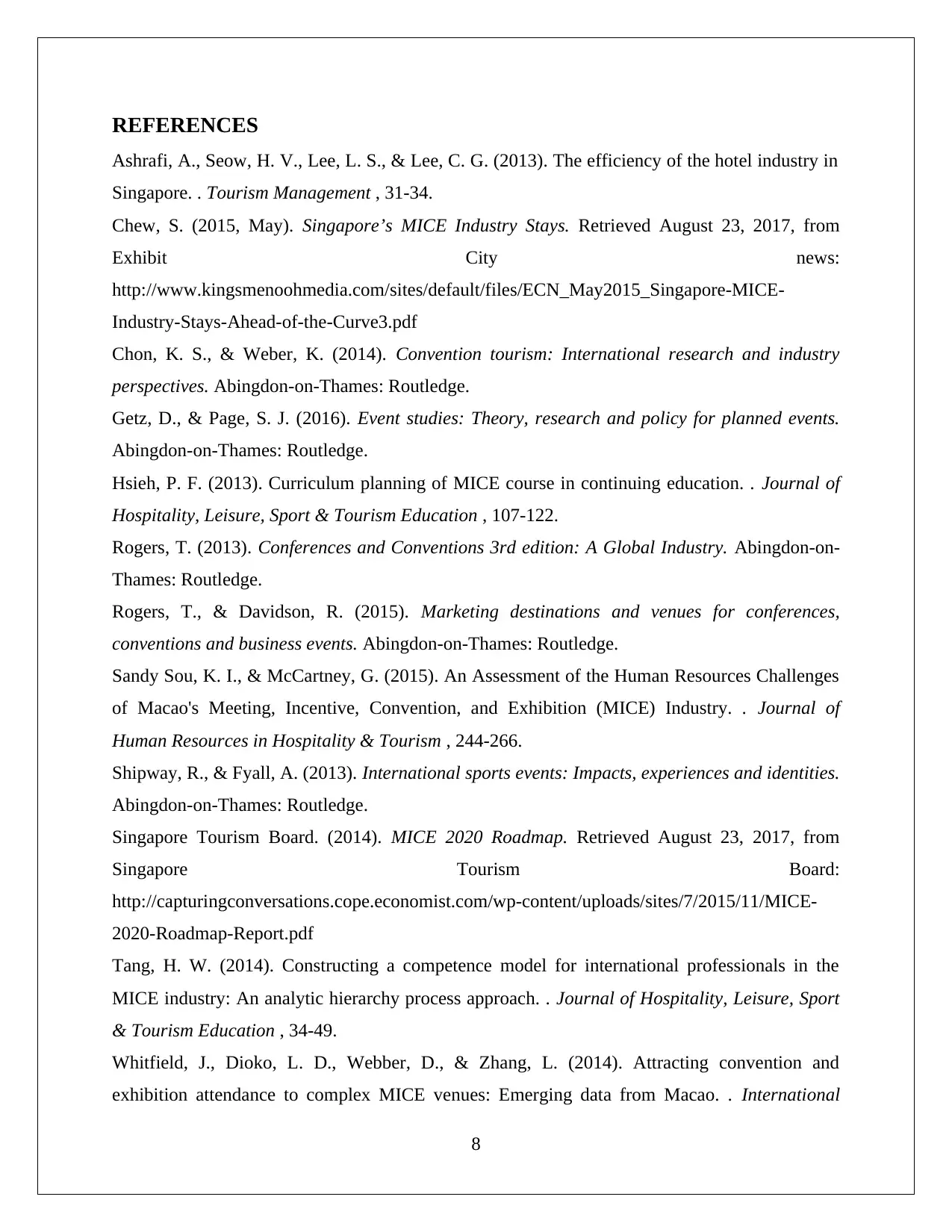
REFERENCES
Ashrafi, A., Seow, H. V., Lee, L. S., & Lee, C. G. (2013). The efficiency of the hotel industry in
Singapore. . Tourism Management , 31-34.
Chew, S. (2015, May). Singapore’s MICE Industry Stays. Retrieved August 23, 2017, from
Exhibit City news:
http://www.kingsmenoohmedia.com/sites/default/files/ECN_May2015_Singapore-MICE-
Industry-Stays-Ahead-of-the-Curve3.pdf
Chon, K. S., & Weber, K. (2014). Convention tourism: International research and industry
perspectives. Abingdon-on-Thames: Routledge.
Getz, D., & Page, S. J. (2016). Event studies: Theory, research and policy for planned events.
Abingdon-on-Thames: Routledge.
Hsieh, P. F. (2013). Curriculum planning of MICE course in continuing education. . Journal of
Hospitality, Leisure, Sport & Tourism Education , 107-122.
Rogers, T. (2013). Conferences and Conventions 3rd edition: A Global Industry. Abingdon-on-
Thames: Routledge.
Rogers, T., & Davidson, R. (2015). Marketing destinations and venues for conferences,
conventions and business events. Abingdon-on-Thames: Routledge.
Sandy Sou, K. I., & McCartney, G. (2015). An Assessment of the Human Resources Challenges
of Macao's Meeting, Incentive, Convention, and Exhibition (MICE) Industry. . Journal of
Human Resources in Hospitality & Tourism , 244-266.
Shipway, R., & Fyall, A. (2013). International sports events: Impacts, experiences and identities.
Abingdon-on-Thames: Routledge.
Singapore Tourism Board. (2014). MICE 2020 Roadmap. Retrieved August 23, 2017, from
Singapore Tourism Board:
http://capturingconversations.cope.economist.com/wp-content/uploads/sites/7/2015/11/MICE-
2020-Roadmap-Report.pdf
Tang, H. W. (2014). Constructing a competence model for international professionals in the
MICE industry: An analytic hierarchy process approach. . Journal of Hospitality, Leisure, Sport
& Tourism Education , 34-49.
Whitfield, J., Dioko, L. D., Webber, D., & Zhang, L. (2014). Attracting convention and
exhibition attendance to complex MICE venues: Emerging data from Macao. . International
8
Ashrafi, A., Seow, H. V., Lee, L. S., & Lee, C. G. (2013). The efficiency of the hotel industry in
Singapore. . Tourism Management , 31-34.
Chew, S. (2015, May). Singapore’s MICE Industry Stays. Retrieved August 23, 2017, from
Exhibit City news:
http://www.kingsmenoohmedia.com/sites/default/files/ECN_May2015_Singapore-MICE-
Industry-Stays-Ahead-of-the-Curve3.pdf
Chon, K. S., & Weber, K. (2014). Convention tourism: International research and industry
perspectives. Abingdon-on-Thames: Routledge.
Getz, D., & Page, S. J. (2016). Event studies: Theory, research and policy for planned events.
Abingdon-on-Thames: Routledge.
Hsieh, P. F. (2013). Curriculum planning of MICE course in continuing education. . Journal of
Hospitality, Leisure, Sport & Tourism Education , 107-122.
Rogers, T. (2013). Conferences and Conventions 3rd edition: A Global Industry. Abingdon-on-
Thames: Routledge.
Rogers, T., & Davidson, R. (2015). Marketing destinations and venues for conferences,
conventions and business events. Abingdon-on-Thames: Routledge.
Sandy Sou, K. I., & McCartney, G. (2015). An Assessment of the Human Resources Challenges
of Macao's Meeting, Incentive, Convention, and Exhibition (MICE) Industry. . Journal of
Human Resources in Hospitality & Tourism , 244-266.
Shipway, R., & Fyall, A. (2013). International sports events: Impacts, experiences and identities.
Abingdon-on-Thames: Routledge.
Singapore Tourism Board. (2014). MICE 2020 Roadmap. Retrieved August 23, 2017, from
Singapore Tourism Board:
http://capturingconversations.cope.economist.com/wp-content/uploads/sites/7/2015/11/MICE-
2020-Roadmap-Report.pdf
Tang, H. W. (2014). Constructing a competence model for international professionals in the
MICE industry: An analytic hierarchy process approach. . Journal of Hospitality, Leisure, Sport
& Tourism Education , 34-49.
Whitfield, J., Dioko, L. D., Webber, D., & Zhang, L. (2014). Attracting convention and
exhibition attendance to complex MICE venues: Emerging data from Macao. . International
8
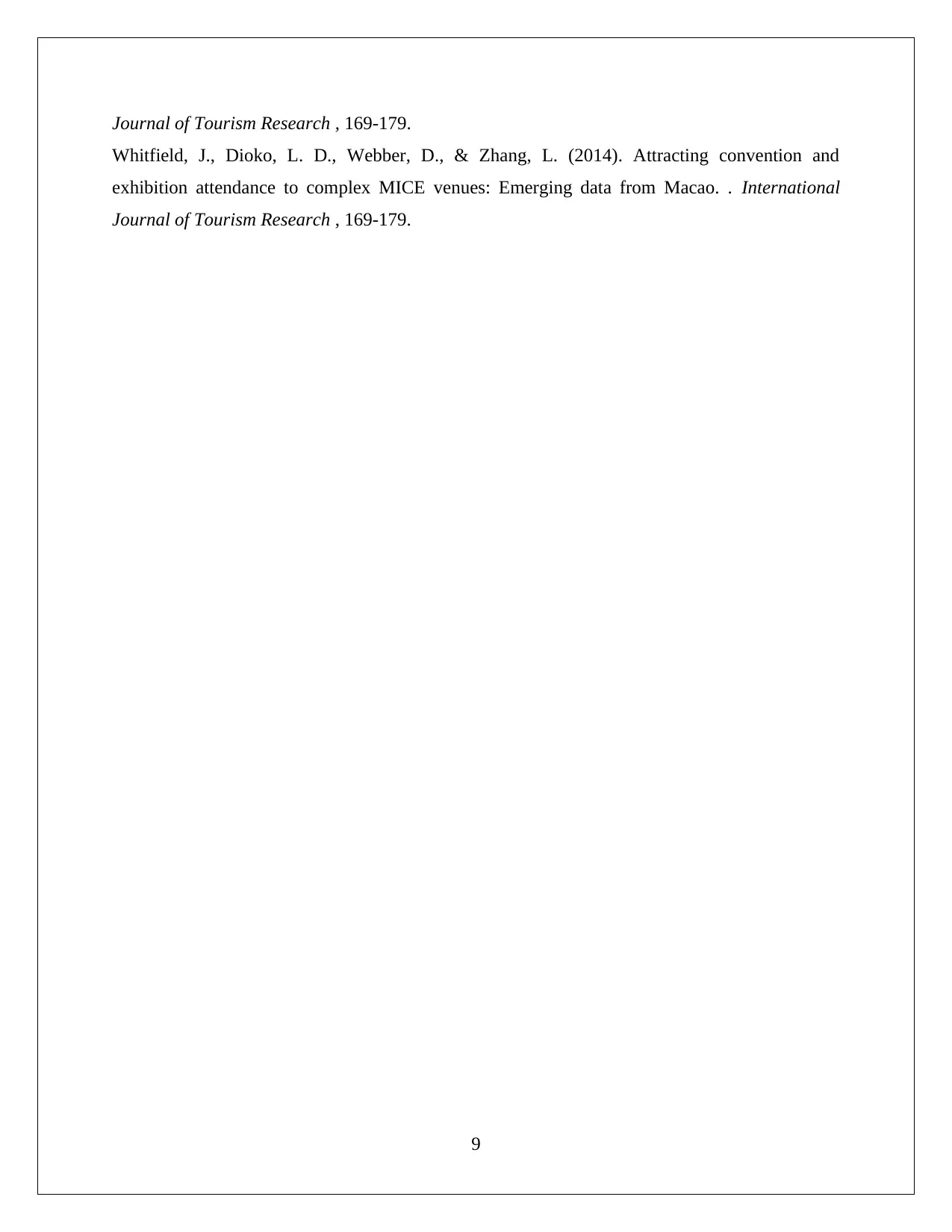
Journal of Tourism Research , 169-179.
Whitfield, J., Dioko, L. D., Webber, D., & Zhang, L. (2014). Attracting convention and
exhibition attendance to complex MICE venues: Emerging data from Macao. . International
Journal of Tourism Research , 169-179.
9
Whitfield, J., Dioko, L. D., Webber, D., & Zhang, L. (2014). Attracting convention and
exhibition attendance to complex MICE venues: Emerging data from Macao. . International
Journal of Tourism Research , 169-179.
9
⊘ This is a preview!⊘
Do you want full access?
Subscribe today to unlock all pages.

Trusted by 1+ million students worldwide
1 out of 9
Related Documents
Your All-in-One AI-Powered Toolkit for Academic Success.
+13062052269
info@desklib.com
Available 24*7 on WhatsApp / Email
![[object Object]](/_next/static/media/star-bottom.7253800d.svg)
Unlock your academic potential
Copyright © 2020–2025 A2Z Services. All Rights Reserved. Developed and managed by ZUCOL.





